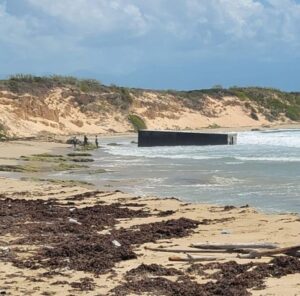Construction drag continues
Sector records third consecutive quarter of decline
Lower output from reduced building activities led to a third consecutive quarterly decline for the construction industry, with estimates that the sector contracted 2.4 per cent during the April to June quarter, according to preliminary data released by the Planning Institution of Jamaica (PIOJ) this week.
PIOJ Director General Dr Wayne Henry said the reduction in real value added for construction stemmed mainly from a downturn in activities across both the ‘Building Construction’ and ‘Other Construction’ subsectors as housing construction declined and recent road projects come to an end. Preliminary data on sales for construction inputs further reflected a 7 per cent decline in real terms.
“The decline in the ‘Other Construction’ component was due to reduced capital expenditure on civil engineering activities, [while] the building component is estimated to have contracted due to a 7.6 per cent decline in housing starts by the National Housing Trust (NHT),” Henry said in an update on economic performance at a quarterly briefing held on Wednesday.
Over the reporting period, a decline in spend by agencies such as the National Works Agency (NWA), down 72 per cent, and the Jamaica Public Service (JPS), down 21 per cent, drove the reduced output seen for the ‘Other Construction’ component. A further decline in the segment the PIOJ said was, however, tempered by increased expenditure from the National Road Operating and Construction Limited (NROCC) after it spent $5.2 billion more on the Montego Bay perimeter road.
Following significant booms during the COVID-19 pandemic, the construction industry has over the last four quarters registered mixed performance starting with a 0.7 per cent decline for the corresponding April-June period of last year followed by a similar 0.7 per cent in growth for the July-September quarter. Downturns recorded in the subsequent October-December 2023 and January-March 2024 quarters were -3.8 per cent and -3.7 per cent, respectively.
Following a similar slowing of residential and commercial real estate projects being executed by private developers, much of which have stalled as a result of higher interest rates in the market, the industry generally continues to lag, though there is great expectation that it will rebound as it gets back to that peak season.
The PIOJ, in its own assessment and outlook for the industry, said its return to growth could come as early as the latter part of the 2024/25 fiscal year following the period of “increased rebuilding and repair activities associated with recovery from Hurricane Beryl as well as the ramping up of activities under the Relief Emergency Assistance and Community Help (REACH) road rehabilitation programme” now underway.
Coupled with the output from manufacturing, which saw flat growth of 0.0 per cent, construction was the only other within the goods producing industry to have weighed on its performance. Together with 6.2 per cent in value added from mining and quarrying and 2.7 per cent from agriculture, the goods producing industry grew marginally at 0.8 per cent.
The services industry, which, on the other hand, saw much smaller output of 0.1 per cent, also benefited from higher real value added for all industries with the exception of ‘Wholesale & Retail Trade’; ‘Repair & Installation of Machinery (WRTRIM)’ and ‘Producers of Government Services’, which declined during the period. As a result of these movements, the local economy for the April-June quarter, the PIOJ said, remained relatively flat, recording an estimated growth of 0.1 per cent when compared with the corresponding quarter of 2023.
“The out-turn for the review quarter largely reflected the normalisation of performances of most industries following the return to pre-COVID-19 levels of output in 2023. Specifically, the performance mainly reflected the estimated downturns in the WRTRIM and construction industries as well as a slowing in the pace of growth in most other industries,” Henry said.
Linked to fallouts from Hurricane Beryl which severely impacted parishes along the island’s southern coast in early July, the PIOJ, amid the lacklustre performance for the April-June quarter, has projected negative growth for the current July-September quarter. The expectation is for the economy at the end of that period to contract within the range of -0.1 per cent to -1.0 per cent. In light of this, a fiscal year projection was also given, which puts forward gross domestic product (GDP) change within the range of -1.0 per cent to 1.0 per cent.
“Despite the challenges that abound, we remain optimistic as we continue to closely monitor and assess these developments,” Henry said.













